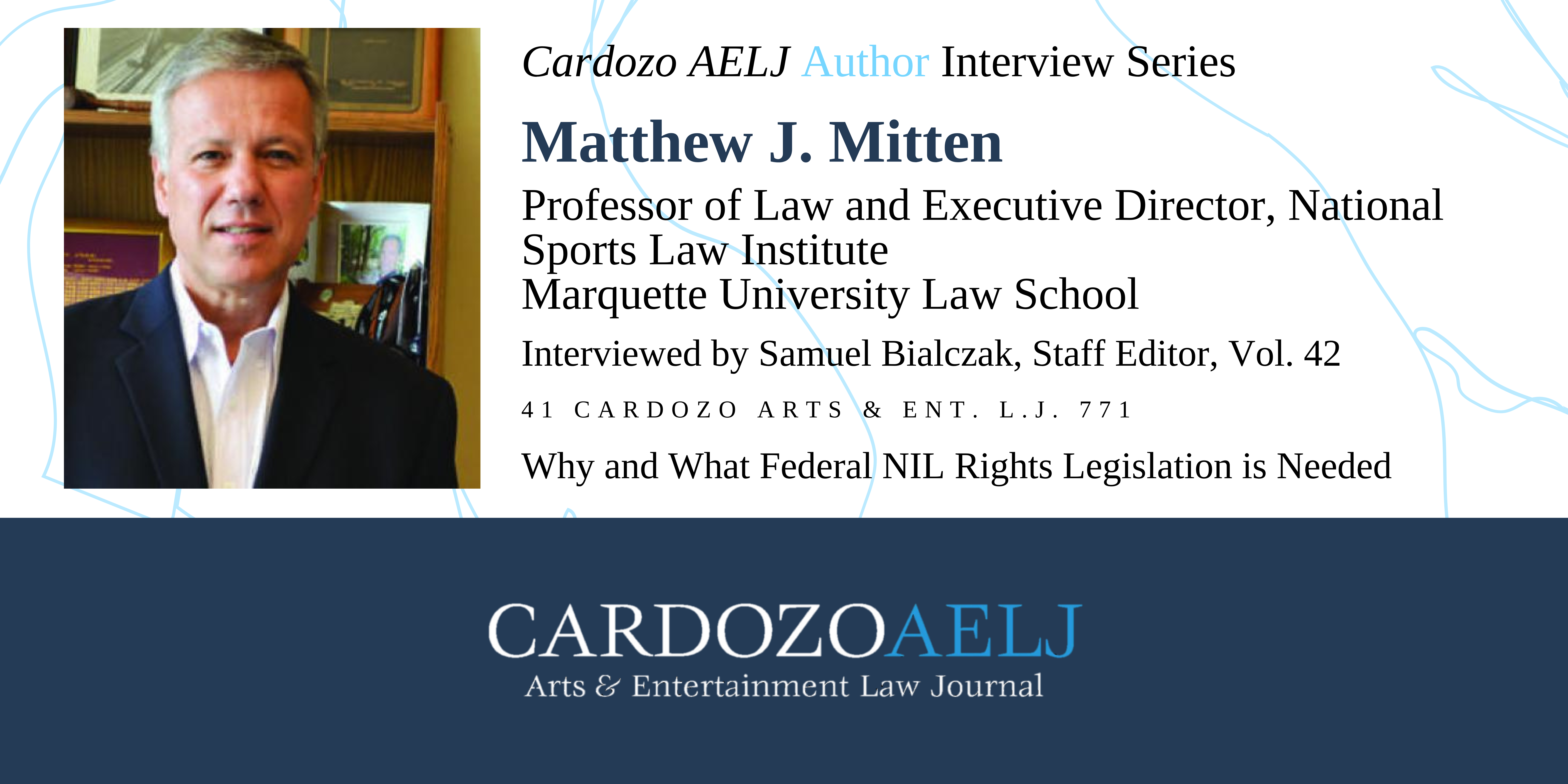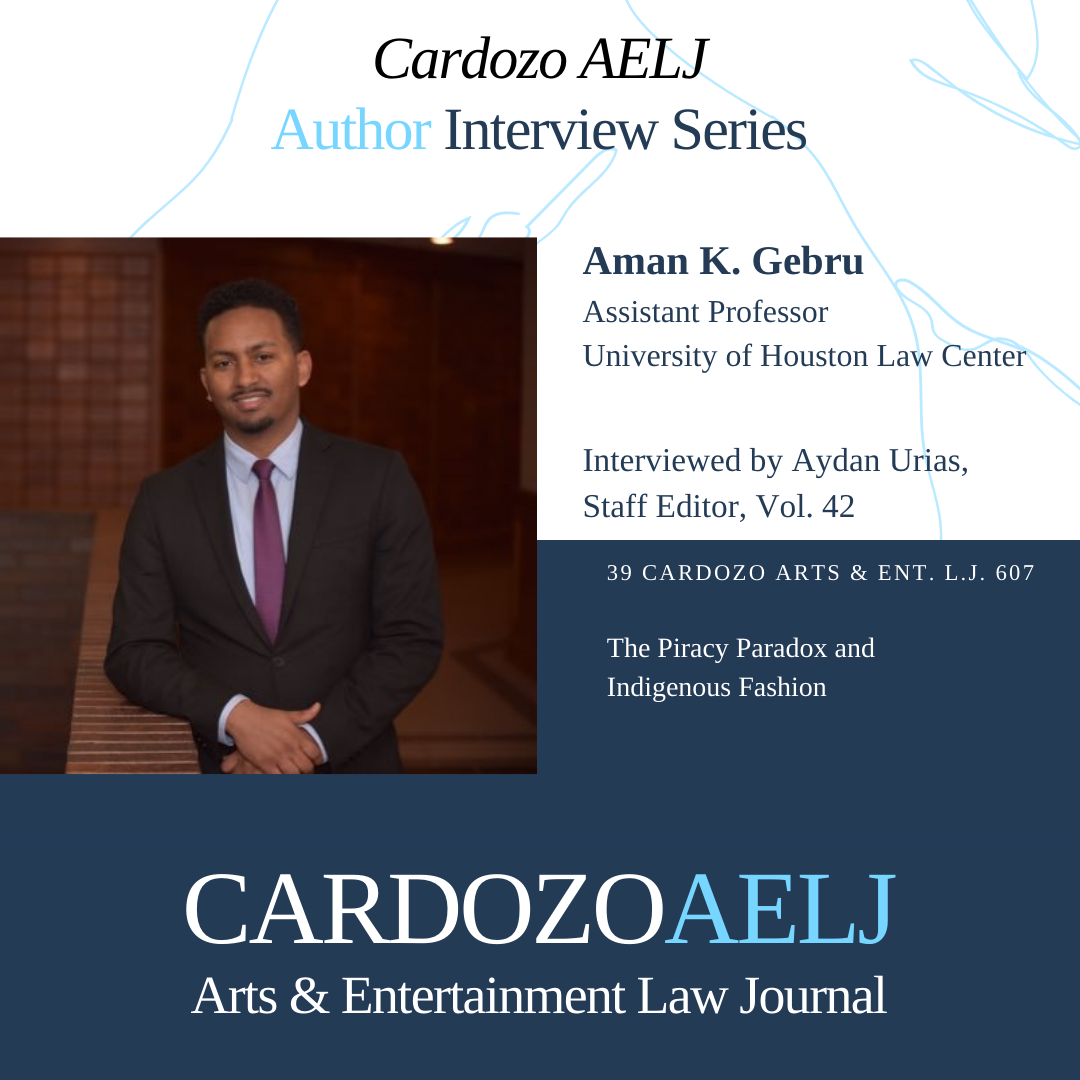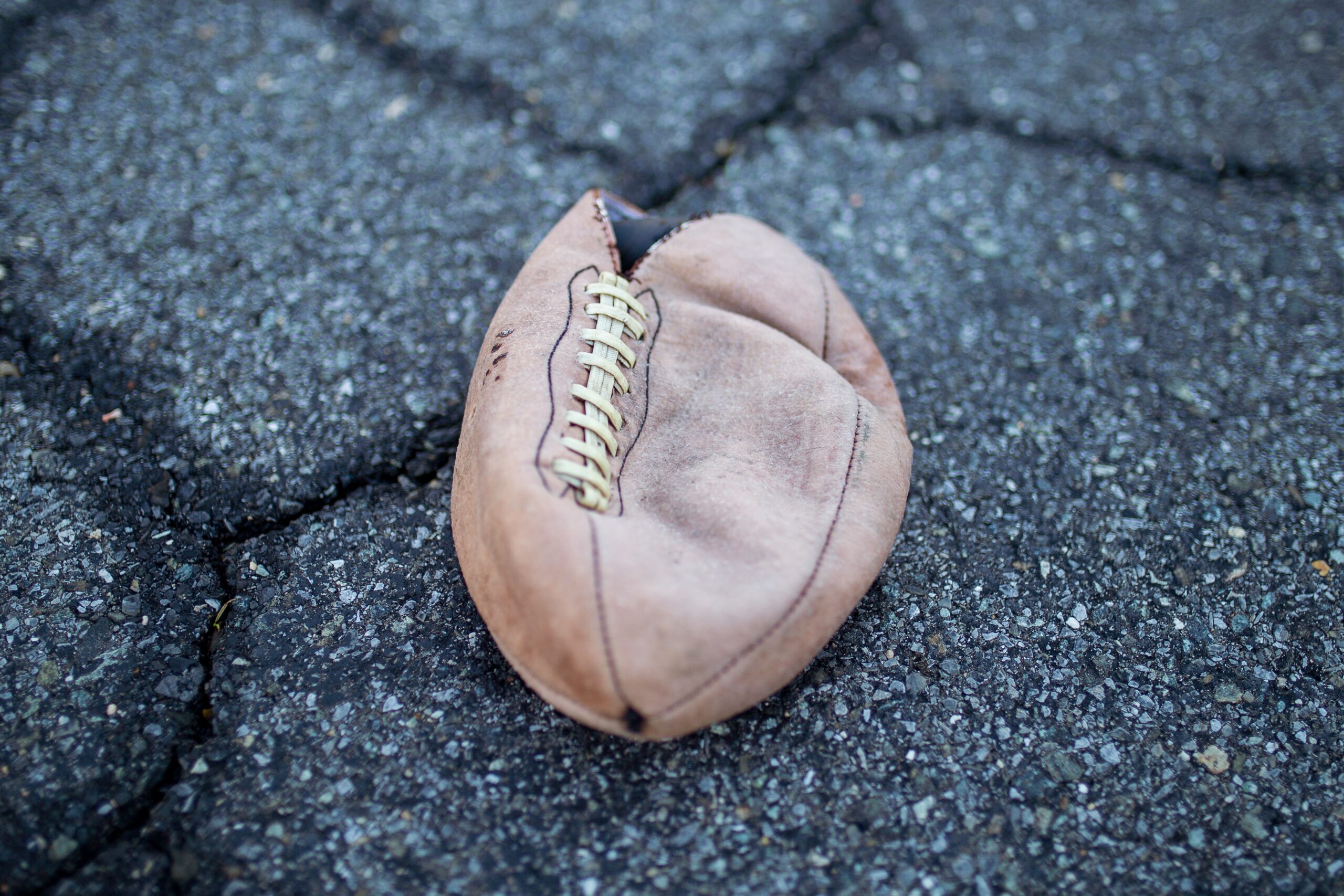Cardozo AELJ Author Interview Series: Matthew J. Mitten
ByOnline Editor
- On
The Cardozo AELJ Author Interview Series seeks to give our readers further insight into the Articles and Notes published in the Cardozo Arts & Entertainment Law Journal. In this interview, Professor Matthew J. Mitten discusses his Article, Why and What Federal NIL Rights Legislation is Needed, which was published in Volume 41, Issue 3.
Matthew J. Mitten is the Professor of Law and Executive Director of the National Sports Law Institute at Marquette University Law School. Professor Mitten is a leading sports law scholar and has testified before a U.S. Congressional joint subcommittee, the Senate Judiciary Committee, and the Senate Commerce Committee, as well as the Knight Commission on Intercollegiate Athletics, on college sports law issues.
Our interview with Professor Mitten was conducted by Samuel Bialczak. Samuel is a Second Year Law Student at the Benjamin N. Cardozo School of Law and a Staff Editor for Vol.42 of the Cardozo Arts & Entertainment Law Journal. Samuel is interested in corporate law, specifically mergers & acquisitions, private equity, and restructuring.
SB: What made you decide to write about Name, Image, Likeness (“NIL”) legislation? Were you merely intrigued by the topic or were you previously a student athlete?
MM: I was not a college student athlete, but I have taught Sports Law since 1990. Of course, the National Collegiate Athletics Association’s (“NCAA”) historical model of college sports is based on an amateur academic model. Up until prior to July 2021, the NCAA and college athletes under the National Association of Intercollegiate Athletics (“NAIA”) focused on the idea that you could not receive any NIL rights income because that would professionalize yourself. I wanted to keep up with sports law developments. I am a co-author of one of the leading casebooks, and have testified twice before Senate committees, first the judiciary and then the commerce committee.
SB: There are currently four proposals for a federal NIL enactment, such as the College Athlete Economic Freedom Act, The Protecting Athletes, Schools and Sports Act of 2023, the Student Athlete Level Playing Field Act, and the College Athletes Protection and Compensation Act of 2023. Do you foresee any of these proposals being enacted? Why or why not?
MM: To go back a couple years, I had testified first before the Senate Judiciary Committee in July 2020, and then I think June of 2021. Having talked to both sides of the aisle, and most recently, there was a Senate Judiciary Committee hearing, I think both sides are aligned on three things.
One: there should be a uniform federal law that applies across the board. Right now it is my understanding is that there are 30+ states all of which have somewhat different NIL laws and it is to a race to the bottom. Someone else is making it more liberal, as the current guidelines are divisional, and they are the same across NCAA Divisions 1, 2, and 3. Member schools must comply with the laws of the state in which they are located is utilized across the board. Then, if there is not one, there are some guidelines: one is no pay for play, NIL deals are not supposed to be used as recruiting inducements, but we can find plenty of examples where both of those are being violated. I think there is an agreement that one uniform federal law should exist. The second area of agreement would be preemption of any state laws, you would not need any state laws. The third area of agreement would be a very limited anti-trust exemption or safe harbor that would give the association the authority to enforce whatever NIL rights laws that Congress, or if they establish a commission on that, believe are appropriate. There is agreement on that.
But my understanding is that the issue is whether NIL rights should be part of a broader federal law that would regulate federal sports. Should it include things like protecting scholarships, providing healthcare benefits, those sorts of things. So as a general rule, the Republican side says let’s just start with the NIL piece and focus on that. Whereas the Democratic side, particularly Senator Booker and Senator Richard Blumenthal have the view, I think, that the bill must be broader. Since there is not a substantial majority in either House, things have gotten bogged down.
The argument I had made when I talked to the Commerce Committee was that we could pattern this after the World Anti-Doping Code, where prior to that adoption in 2003, each of the Olympic sports had their own anti-doping rules and sanctions. The idea was that it ought to be harmonized throughout the world, and it was a unique public private partnership. Everyone gave a little bit, but it has been workable and every six years they gather and make whatever modifications are needed. What I said was you cannot have a balkanized system where there are different roles applying to different athletes; for example, like we have here, because one of the hallmarks of sport is that everyone plays by the same rules. You have to have that to have some modicum of competitive balance.
SB: You, and many others, had warned about the NIL and unfair competition, as some states have a bit more leeway with recruitment tactics. With the downfall of numerous college football conferences such as the Pacific-12 Conference (“PAC-12”), do you foresee more conferences disbanding until federal NIL legislation is enacted?
MM: I am not sure what is causing the game of conference musical chairs is caused by NIL issues. The Big 10 Conference (“Big 10”) and the Southeastern Conference (“SEC”), particularly the Big Ten,is misnamed as it has 18 schools now. Because of the population base, their television contracts are bigger than the other conferences. For established members, it is a pro-rata distribution. So what has happened is schools such as University of California, Los Angeles (“UCLA”) and University of Southern California (“USC”) (who got the ball rolling) realized they would be better off economically being in the Big Ten market by getting a larger pro-rata share of the conference’s media rights by being in the Big Ten market. The Big Ten realized by adding the Los Angeles market, they would increase the value of their television rights.
There are two things that are driving this: the first being whether conference member schools play football and the second being its pro-rata revenue sharing. For example at Marquette, the Big East Conference (“Big East”) used to be a mix of football and basketball schools, which broke up. Now, the Big East is strictly basketball, which has worked somewhat well for them. That is what is driving these issues I think, as opposed to a piecemeal state-by-state NIL rights. You still have the same NIL rights issues, perhaps even more magnified, as you are adding schools from different states with different laws now.
SB: Caleb Williams, a former Oklahoma and USC quarterback, stated that he wanted to be drafted by specific teams, and if not, he would stay at USC, even going so far as to state he wanted equity in the USC football program. His reasoning was due to making enough money at USC. Do you think this is a negative consequence of permitting NIL deals to collegiate athletes? Has this become a “minor league” rather than a collegiate extracurricular activity?
MM: Well, if you really look at it, these are not really NIL rights deals. The money is largely dependent on going to a particular school. When Caleb Williams announced he would transfer from Oklahoma a few years ago, Charlie Batch (former Steelers quarterback who had played at Eastern Michigan and has some role with a financial services company) tweeted Caleb to come to Eastern Michigan to receive a million-dollar NIL rights deal. Arguably, what you have are athletes having seven-figure deals and becoming pay-for-play. It is conditioned upon going to that school due to a collective.
If you compare it to a lot of the deals female athletes are getting, they are getting paid based on the fair market value of being an endorser of various products and services. If you even compared the quarterbacks for the Rams and Chargers, for example, I would bet Caleb Williams’s NIL rights deals are greater on that. This is because he is getting paid from those associated with the University of Southern California wanting him to come there. This probably overstates his fair market value as an endorser of products and services. Arguably, these really big deals are a type of pay-for-play.
One of the things that would be a beneficial effect would be for an athlete not like Caleb Williams, but someone who is pondering whether to go to the NFL after the collective bargaining rule of three years post-graduation from high school or staying a fourth year. They have to establish whether they are better off receiving a six-figure NIL earning the academic achievement bonuses, or staying a fourth year, improve as a player, and get my degree. When you have someone like Caleb Williams, this is just an individual becoming greedy—but there is no prohibition on this. For starters, he will not pick his team, there is a collectively bargained draft, and he will quickly get drafted. He could attempt to state he will not play for the team, but that is not a wise strategy…where would he go? The XFL or Canadian Football League?
Regarding his request for equity, there is no provision prohibiting this in the collective bargaining agreement. However, arguably, you have an equity interest that would increase your compensation and put the club above the salary cap. The league would likely say no. There is a bit of a conflict of interest here, as you have an ownership interest in the team, and you are an employee of the team under contract. Why would you give an untested rookie equity interest before someone like Aaron Rodgers, or Patrick Mahomes at the professional level? I think he is likely blowing smoke and mirrors, likely his agent whispering in his ear. I think this is quite problematic.
While there is nothing wrong with earning your way to get to this level, but if I were team, this would raise concerns. As great of a talent an athlete may be, is this who you want on your team? Look at the amount of amazing college players who do not play well in the pros. Ryan Leaf, taken second overall years ago, is known as one of the biggest busts of all-time. Kyler Murray could have played baseball, and probably had a longer career. Imagine Aaron Donald hearing that Caleb Williams was asking for equity interest, seems like the type of player who will get hit quite often. It is a team sport, and while quarterbacks are seen to be leaders, you need your offensive line to block for you, you need your receivers to catch what you throw. I think this is an unintended consequence of NIL enactment. It was designed to allow for college athletes to share in the substantial revenues that are generated in collegiate sports. It looks like a significant amount of money is going strictly to football players. I would have assumed basketball would have a larger share.
It will be interesting how it all shakes out. I think we might see, because Division One is considering adding additional guidelines, and I think at some point, we will see an enforcement action being brought forward against a school for not following these guidelines. The big thing now is the risk of federal anti-trust lawsuits challenging this. Either the school could bring it, or an athlete if it adversely effects his or her eligibility, or if a representative of one’s athletic interests could bring it. One of the sanctions that could be imposed by the Division would be that the school must disassociate themselves from a specific booster. Maybe the booster can no longer have season tickets, donate money, or sponsor the school. Arguably, they may have standing to bring an anti-trust suit there. That is big. Look at the last couple associations that have lost. When you have mandatory damages and a fee-shifting statute, you need to think a lot about the anti-trust sword being raised and what is the substantial likelihood you can defend yourself.
SB: While federal enactment should level the playing field, the one-size-fits-all approach may not work for an institution, severely impacting their athletic programs. Do you think there are valid concerns regarding undermining a university’s autonomy to make NIL decisions?
MM: I do not think so. The idea is that schools collectively make the rules and produce the sport. I would analogize it to a rule stating one school cannot have twelve players on the field and another with eleven. You must have the same eligibility rules. That is one of the problems with just having athletes partaking in the revenue-generating sports at private schools, they could unionize, like when they tried to do that with the Northwestern football players. For public schools, whether their athletes can unionize is a matter of state law.
The National Labor Relations Board said it would not make sense to have one group of athletes at one school to be collectively bargaining perhaps different terms and conditions than other schools. There needs to be uniformity among those who are playing at the same level of competition. That is why we have different divisions. For example, maybe different rules for Division 3, Division 2, maybe even within Division 1. The Alston case says if two or more conference members agree amongst themselves, they may have market power and that shifts the burden to show the challenge restraint furthers at least one pro-competitive objective, and there is no substantially less-restrictive alternative.



